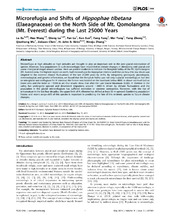| dc.contributor.author | Xu, Lu | eng |
| dc.contributor.author | Wang, Hao | eng |
| dc.contributor.author | La, Qiong | eng |
| dc.contributor.author | Lu, Fan | eng |
| dc.contributor.author | Sun, Kun | eng |
| dc.contributor.author | Fang, Yang | eng |
| dc.contributor.author | Yang, Mei | eng |
| dc.contributor.author | Zhong, Yang | eng |
| dc.contributor.author | Wu, Qianhong | eng |
| dc.contributor.author | Chen, Jiakuan | eng |
| dc.contributor.author | Birks, Harry John Betteley | eng |
| dc.contributor.author | Zhang, Wenju | eng |
| dc.date.accessioned | 2015-03-31T08:58:53Z | |
| dc.date.available | 2015-03-31T08:58:53Z | |
| dc.date.issued | 2014-05-19 | eng |
| dc.identifier.issn | 1932-6203 | en_US |
| dc.identifier.uri | https://hdl.handle.net/1956/9709 | |
| dc.description.abstract | Microrefugia at high altitudes or high latitudes are thought to play an important role in the post-glacial colonization of species. However, how populations in such microrefugia have responded to climate changes in alternating cold glacial and warm interglacial stages remain unclear. Here we present evidence to indicate the Rongbuk Valley of the Mt. Qomolangma (Mt. Everest) area, the highest region on earth, had microrefugia for Hippophae tibetana and discuss how this low shrub was adapted to the extreme climate fluctuations of the last 25,000 years by shifts. By integrating geological, glaciological, meteorological, and genetic information, we found that the Rongbuk Valley was not only a glacial microrefugium but also an interglacial microrefugium for H. tibetana: the former was located on the riverbank below 4800 m above sea level (asl) or lower area and the latter at ~5000 m asl. Our results show that after the Last Glacial Maximum (LGM), H. tibetana in the valley has undergone upward and downward migrations around ~5000 m driven by climate fluctuations and the population in the glacial microrefugium has suffered extinction or extreme contraction. Moreover, with the rise of temperature in the last four decades, the upper limit of H. tibetana has shifted at least 30 m upward. Combining population history and recent range shift of this species is important in predicting the fate of this endemic species to future climate changes. | en_US |
| dc.language.iso | eng | eng |
| dc.publisher | PLoS | en_US |
| dc.rights | Attribution CC BY | eng |
| dc.rights.uri | http://creativecommons.org/licenses/by/4.0 | eng |
| dc.title | Microrefugia and shifts of Hippophae tibetana (Elaeagnaceae) on the north side of Mt. Qomolangma (Mt. Everest) during the last 25000 years | en_US |
| dc.type | Peer reviewed | |
| dc.type | Journal article | |
| dc.date.updated | 2015-03-03T15:53:33Z | en_US |
| dc.description.version | publishedVersion | en_US |
| dc.rights.holder | Copyright 2014 Xu et al | en_US |
| dc.source.articlenumber | e97601 | |
| dc.identifier.doi | https://doi.org/10.1371/journal.pone.0097601 | |
| dc.identifier.cristin | 1161602 | |
| dc.source.journal | PLoS ONE | |
| dc.source.40 | 9 | |
| dc.source.14 | 5 | |
| dc.subject.nsi | VDP::Mathematics and natural scienses: 400::Zoology and botany: 480::Vegetation history: 495 | en_US |
| dc.subject.nsi | VDP::Mathematics and natural scienses: 400::Basic biosciences: 470::Genetics and genomics: 474 | en_US |
| dc.subject.nsi | VDP::Matematikk og naturvitenskap: 400::Basale biofag: 470::Genetikk og genomikk: 474 | nob |
| dc.subject.nsi | VDP::Matematikk og naturvitenskap: 400::Zoologiske og botaniske fag: 480::Vegetasjonshistorie: 495 | nob |

